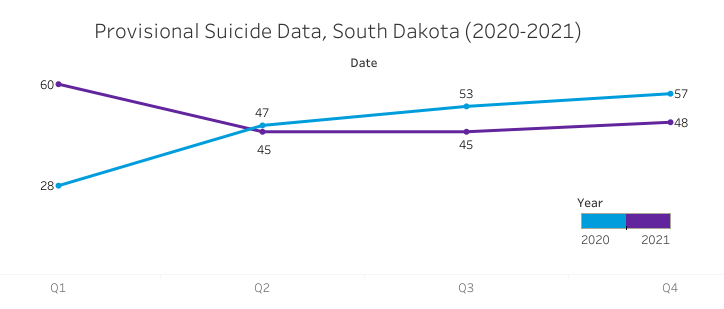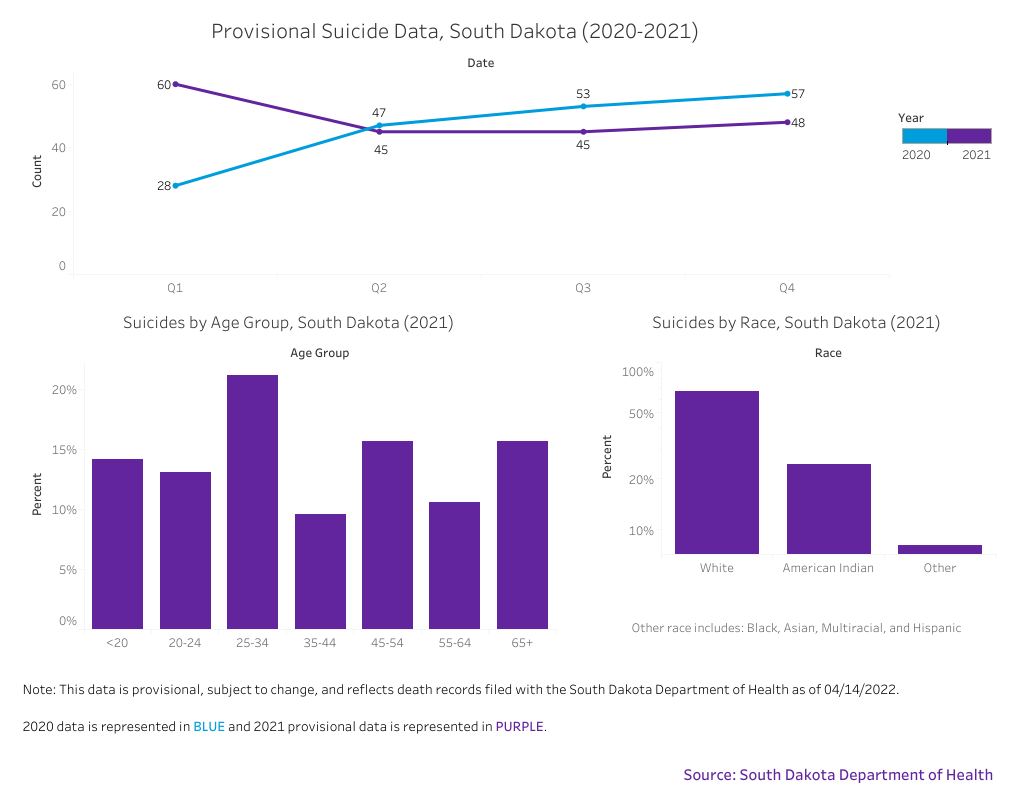Record number of South Dakotans died by suicide in 2021
Suicides in South Dakota increased to a record level last year, according to provisional data released by the South Dakota Department of Health in April.
In 2021, 198 South Dakotans died by suicide. This is higher than in 2019 and 2020, which each had 185 suicides, and is the highest ever recorded in the state.
The finalized death data from 2020 show several significant problems for South Dakota:
- South Dakota had the 8th highest suicide rate in the United States in 2020.
- Four South Dakota counties rank in the top 1% highest suicide rates in the U.S. (2010-2019).
- American Indian suicide rates are 2.5 times higher than White race rates in South Dakota (2011-2020).
- In 2020, suicide was the leading cause of death among those ages 10-19 and the second-leading cause of death among those ages 20-29.
“The particularly strong impact on youth and young adults is concerning for the future of our state,” said Erik Muckey, CEO and Executive Director of Lost&Found.
Pandemic-related increase
The timing of the increase—with more suicides in the second, third, and fourth quarters of 2020 and the first quarter of 2021—suggest that the increase is at least in part related to the COVID-19 pandemic.
“While we continue to analyze underlying factors for this record, we know that the pandemic impeded many of the protective factors against suicide while increasing certain risk factors for suicide,” Muckey said.
These are some of the protective factors that prevent suicide that were affected by the pandemic:
- Access to mental health care – Many people who had been seeing a mental health professional were not able to continue that care in person when social distancing was practiced. (Meeting through video conferencing allowed care to continue in many cases.)
- Connectedness to others – Social distancing made connecting with others more difficult. Connecting through technology helped but wasn’t quite the same and left out people without access to or knowledge of that technology.
- Sense of purpose in life – Layoffs and school closings may have diminished the sense of purpose for some people.
- Talking about mental health – Mental health concerns may have been more difficult to discuss when not face to face with another person.
The pandemic also increased some of the risk factors that increase the risk of suicide:
- Substance use disorders – For those struggling with a substance use disorder, staying home more often when work and other places were closed may have increased substance use.
- Family dysfunction – People who otherwise might have left home for work or school were less likely to do so during the pandemic, which may have exacerbated fraught family dynamics.
- Endured prolonged stress or a traumatic event – Because of the pandemic, more people were dealing with illness and death of a loved one. Prolonged social isolation can also be damaging to mental health.
Just because suicides increased during the pandemic does not mean, unfortunately, that the end of the pandemic (whenever that is) will result in lower suicide rates. Research suggests that the mental health effects of the pandemic will last beyond the reduction of physical illness in society, especially for those more closely and seriously affected by Covid-19. Pandemic-related poorer mental health and increased risk of suicide is likely to exist for some time to come.
Comprehensive strategy
We can, however, learn from this moment. The pandemic has shown what happens when much of society sees a reduction in the protective factors that can prevent suicide, and an increase in the factors that can increase risk of suicide. Enacting policies and programs that protect people from suicide and reduce the risk of suicide—especially for those most at risk—can save lives.
Since the factors that lead to suicide come from all levels of society—within individuals, but also in relationships, in communities, and in society as a whole—suicide prevention requires a systemic approach. Lost&Found is one organization out of many working on suicide prevention, but more people, organizations, schools, and workplaces need to get involved in the work of building up protective factors and reducing risk factors.
“The more comprehensive our suicide prevention efforts become, the more effective they will be,” Muckey said. “That is absolutely essential to saving lives.”
Learn more about protective and risk factors in Lost&Found’s Let’s Talk About Mental Health guide, which can be downloaded here. Learn more about getting involved with Lost&Found’s suicide prevention efforts here.


